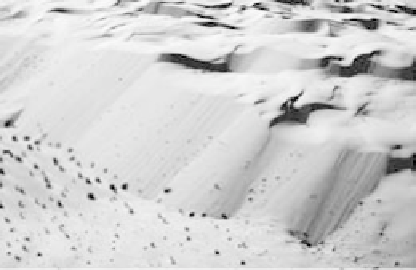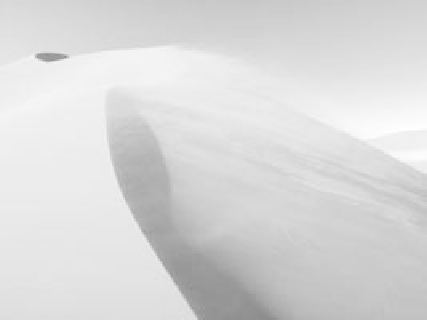Geoscience Reference
In-Depth Information
Fig. 6.70
A consequence of the idea that aeolian ripples have wave-
length approximately equal to the saltation jump length is that
coarser bedstock should give rise to longer wavelength forms. This
is borne out by observations such as here, where granule ridges
(
c
.1 m) in the foreground pass uplsope into “normal”
decimetric-scale ripples under the persons feet.
Fig. 6.73
Dunes are frequently organised into a heirachy of forms.
Here a composite draa has sinuous aklé crests delivering sand to the
brinkpoint of a huge 30 m high slipface; the smaller dunes do not
travel through the larger.
Cloud of bedload jetting
over dune lee crest
Traces of grainflow surges
Fig. 6.74
Dispersive dunes; the imposing
c
.40 m high draa in centre
right of this view is made up of smaller aklé dunes that rise up, over-
top, and pass downwind through the larger form.
Fig. 6.71
Clouds of saltating grains fall out in the dune lee to
produce coarse accumulations that periodically grain flow
downslope. At the same time there is a continuous “rain” of finer
grains.
type (Fig. 6.73), the smaller forms deliver sand to the
brinkpoint of a high slipface so that the smaller dunes do
not travel through the larger.
Flow-parallel aeolian dunes
are exemplified by sharp-
crested longitudinal dunes, individual examples of which
may sometimes be traced for many tens of kilometers
(Fig. 6.75). It has been proposed that the presence of
streamwise secondary flow is of major importance in the
generation of longitudinal aeolian dunes, occurring along
the axis of the meeting point of pairs of oppositely rotating
streamwise vortices. Finer saltating sands are thus always
swept inward in broad lanes where deposition occurs and,
given sufficient sand supply, the duneform grows into
equilibrium with the flow. Once formed, the dunes will
reinforce the secondary flow cells. Although an attractive
theory, and despite many observations, it has not yet been
proven that small-scale sand windrows may grow into large
scale dunes. Opportunities for natural experiments are hin-
dered by the very large scale of the effects searched for.
A closer comparison in terms of scale might be made with
Fig. 6.72
The sinuous crests of aklé dunes. Little is known about the
physical controls upon dune wavelength.
downwind. Such draas are forms of
kinematic waves
, that
is, waves of mass concentration whose velocity is slower
than that of the contributing dunes. A close analogy is
with individual cars arriving, passing through, and leaving
a slower moving stream of traffic on a single carriageway
where overtaking is periodically possible. In the second









Search WWH ::

Custom Search